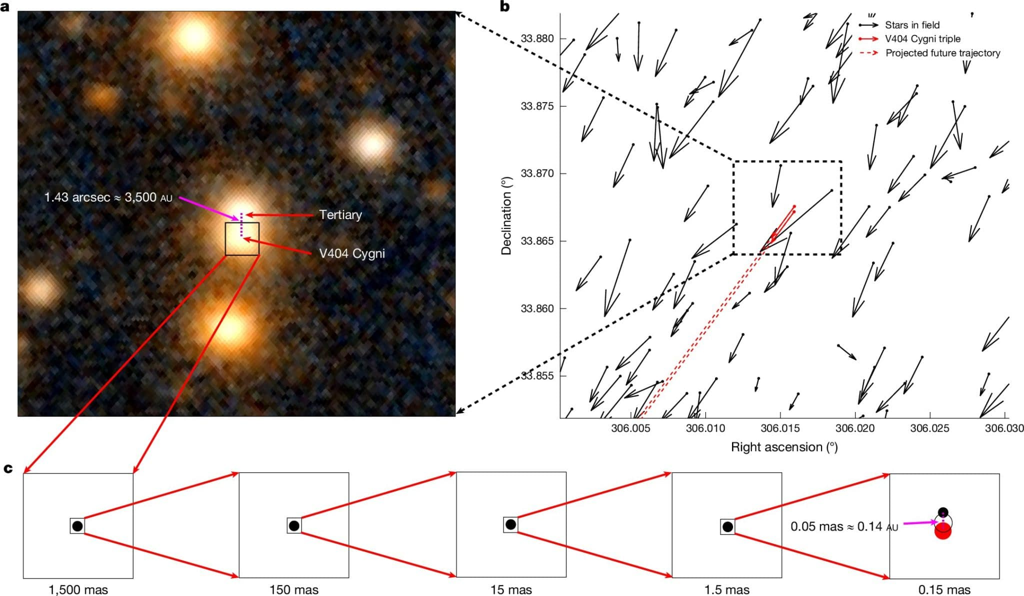Astronomers have discovered a triple system featuring a black hole that formed without a supernova for the first time.
When a massive star explodes as a supernova and undergoes gravitational collapse into a neutron star or black hole, it releases an enormous amount of energy and matter. If this entire process were perfectly symmetrical, the remnants of the star would simply "collapse." However, in practice, the ejection usually gives the object a powerful initial "kick" (natal kick). On one hand, it "assists" in the formation of a compact object. On the other hand, due to the "kick," the object may even be ejected from the system. At the very least, the orbits of its companions are altered.
Theoretical calculations have shown that stellar-mass black holes can form without a supernova and without a strong "kick." In an effort to calculate the minimum "kick" needed for black hole formation, astronomers are studying systems with black holes.
Particularly interesting are systems in which a compact object accretes a neighboring star — these are X-ray binaries. By studying them, researchers concluded that a very strong "kick," exceeding 100 kilometers per second, occurs infrequently. Ultimately, they discovered a system where a black hole appeared to form purely from gravitational collapse.
V404 Cygni is a system located about eight thousand light-years from Earth. It contains one of the first confirmed black holes in history, which was described back in 1992. As a result, it is considered one of the most studied systems. This makes the new discovery even more surprising.
The authors of the study were searching for new black holes when they came across an image of V404 Cygni. They noticed that there was another bright point located close to the V404 Cygni system. Upon checking the speed and direction of this star's movement in the Gaia survey catalog, the scientists concluded that it is part of the V404 Cygni system. The research results have been published in the journal Nature.
It turned out that V404 Cygni is a triple system, with a dense pair consisting of a black hole and an accreting star at its center, while another star orbits at a distance of 3,500 astronomical units from them. The central pair is separated by a distance of 0.14 astronomical units (the average distance from the Sun to the Earth), which is twice as close as Mercury is to the Sun. The third companion is located 25,000 times farther than the distance between the pair, or 90 times farther than Pluto is from the Sun.

To create a complete portrait of the system, especially the "outer" star, the group of scientists combined data from VLT observations, the Gaia survey, the Pan-STARRS telescope system, the Gemini Observatory, the Keck Observatory, and the Hubble Space Telescope. This allowed astronomers to determine that the age of the third companion, and consequently the entire system, is between three to five billion years. The "outer" star is 1.2 times more massive and 1.85 times larger in radius than the Sun. Importantly, its existence places constraints on the history of the black hole's activity.
"Imagine pulling a kite, but instead of a sturdy string, you have a thread. If you pull too hard, the thread will break, and you'll lose the kite. Gravity is similar to this very weak thread. If something abrupt happens with the inner binary, you will lose the outer star," explained one of the authors of the new study, Kevin Burdge from the Massachusetts Institute of Technology (USA).
Through computer simulations, the scientists demonstrated that the system always "survives" when a black hole forms from collapse without a supernova and without a "kick." This contradicts current models, which suggest this is only possible in the case of extremely massive objects, while in this system, the black hole has a mass of about nine solar masses, which is below the theoretical threshold.
If V404 Cygni were 1.5 times farther away, Gaia would not have been able to distinguish the motion of the third companion. If it were 10 percent more massive or 20 percent less massive, it would be too faint for Gaia's instruments.
It's possible that many such systems exist, and many stellar-mass black holes have third companions that our instruments cannot detect. Moreover, as the authors of the new paper noted, most X-ray binaries containing a black hole could have such neighbors. We just need to take a closer look at these objects.